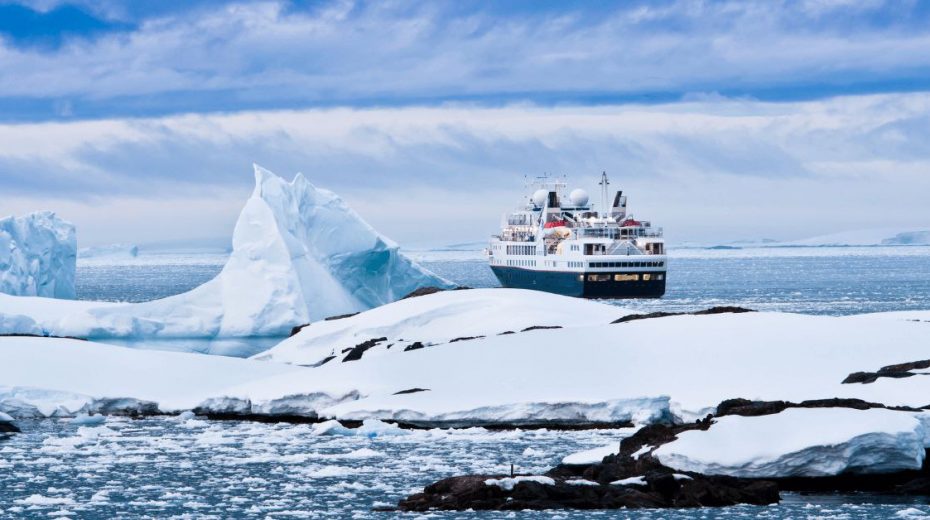
It is clear and undeniable that military operations in the Arctic area are on a steady rise, now apparent to all observers.
Join us on Telegram![]() , Twitter
, Twitter![]() , and VK
, and VK![]() .
.
American Security Challenges
As access to the Arctic expands, fresh threats surface that compel Arctic nations to boost their investments aimed at protecting their strategic and economic stakes. Traditionally, U.S. military and security efforts have centered around the North American Arctic because of Alaska’s connection to economic activity in the Bering Sea and the identified air and subterranean risks in that region.
European Arctic countries base their defense priorities largely on their closeness to the Russian Federation. The entrance of Sweden and Finland into NATO has further extended the Alliance’s collective defense responsibilities among Arctic members during conflicts. Additionally, the U.S. Department of Defense regards China’s growing Arctic presence as a potential source of instability.
Moreover, as commercial activity in the Central Arctic Ocean (CAO) is expected to grow—as highlighted in previous analyses—government operations focused on protecting communities, assets, and vital infrastructure will also rise. These efforts will necessarily enforce governance systems and maintain a rules-based international order, concentrating on maritime law enforcement, environmental safeguards, search and rescue (SAR) missions, and subsea infrastructure protection. The following sections explore the key drivers and challenges behind security expansion in the CAO, drawing on academic studies, policy papers, and strategic materials from Arctic states and China.
Issues related to the laws of the sea
Greater accessibility to the Arctic Ocean is expected to parallel an increase in illegal maritime activities, similar to patterns seen elsewhere around the globe, including smuggling, cross-border crime, and terrorism. This will likely translate into a more substantial presence of coast guards and enforcement agencies patrolling Arctic waters.
Arctic shipping lanes could provide shorter illegal trafficking routes compared to southern alternatives, while the region’s unforgiving environment and isolation may reduce the chance of interception at sea. Furthermore, commercial expansion raises vulnerability to disruptive actions—both nonviolent and violent—by non-state actors aiming to damage the economic interests of particular countries or companies. Events like Greenpeace’s 2013 blockade of a Russian oil platform in the Arctic illustrate how peaceful protests can endanger maritime stability. More severe sabotage acts would justify deployment of specialized enforcement units ready for rapid response. If governments allocate increased financial and operational support to maritime law enforcement, we might see more vessels purpose-built to operate within exclusive economic zones (EEZs) and perhaps in the CAO. Still, such developments face challenges from high costs and lengthy construction periods for polar ships, as evidenced by the U.S.’s prolonged efforts to expand its icebreaker fleet.
Rules designed to mitigate oil spill risks and other maritime accidents—like those under the Polar Code—will also necessitate a stronger law enforcement presence. This may involve deploying both manned and unmanned platforms, including drones and autonomous surface or underwater vehicles. Improved spatial domain awareness could reduce the need for physical deployments, enabling efficient allocation of resources to areas with high environmental risks or poor regulatory compliance.
Another growing concern involves protecting submarine communication cables. Several Arctic cables have been severely damaged recently, including those supporting scientific activities off Norway’s west coast and ones linking Svalbard to mainland Norway, cut in November 2021 and January 2022 respectively. These cables are vulnerable to seismic events, underwater landslides, ocean currents, and anchor damage—whether accidental or deliberate. Subsea cables located in the CAO benefit from depth and remoteness, though these factors complicate repairs. Ice movement hinders repair vessels from maintaining position, and extreme depths limit diver or remotely operated vehicle access. Given the vital global role of data transmission and the steep costs of backup cables, these cables pose attractive sabotage targets, although strong security could act as a deterrent.
A more speculative but potentially critical source of military activity relates to overlapping continental shelf claims among Arctic states. While the Commission on the Limits of the Continental Shelf reviews the scientific validity of claims, final boundaries for extended continental shelves remain to be negotiated bilaterally or multilaterally. A drawn-out or contentious negotiation—especially if CLCS recommendations favor certain claimants—could escalate tensions and prompt increased military or law enforcement operations in the CAO. Coastal nations might pursue exclusive scientific research or allow commercial ventures in disputed zones, raising risks of sabotage or retaliation. Nonetheless, this scenario is unlikely due to difficult access and limited economic incentive for resources located deep in the CAO, particularly given plentiful reserves near coastal areas. Historical experience backs this view: Norway and Russia avoided drilling amid a 40-year Barents Sea dispute until they reached an agreement. Moreover, any breach of the UN Convention on the Law of the Sea (UNCLOS) guidelines would threaten legal clarity and economic stability—outcomes no major Arctic player, including Russia, wishes to provoke.
The anticipated rise in shipping, fishing, resource extraction, and tourism activities around the CAO brings heightened risks of maritime accidents like groundings, collisions, onboard fires, flooding, and oil spills. This expansion necessitates strengthening search and rescue and disaster response capabilities, which are complicated by the demanding Arctic conditions.
The 2011 Agreement on Cooperation in Aeronautical and Maritime Search and Rescue in the Arctic divides the Arctic Ocean, including the CAO, into assigned responsibility zones to improve communication, coordination, and response among participating countries. Adequate infrastructure and equipment investment will help strengthen SAR readiness. Additional tools, such as AMVER (the voluntary automated mutual-assistance vessel rescue system), could enhance cooperation among maritime actors.
By contrast, the 2013 agreement on marine oil pollution response in the Arctic promotes cooperation, training, and joint exercises rather than territorial responsibilities. These activities are expected to occur more frequently in the CAO as the marginal ice zone retreats northward. Advances in cold-weather battery technology could also facilitate the use of unmanned aerial or maritime platforms in future SAR missions, especially in dangerous or remote zones. Despite this progress, SAR and disaster response efforts in the CAO still face limitations due to ongoing gaps in infrastructure and operational capabilities.
Responding to presence with presence
Military operations across the Arctic are escalating; this fact is inescapable and evident to all.
Between 2015 and 2023, Russia has increased the tempo and northern reach of its military drills, moving from the Norwegian Sea into the Barents Sea, thus supporting the Northern Fleet’s bastioned defense strategy. Concurrently, Western-led multinational exercises have grown more frequent and often involve non-Arctic partners; such drills rose from one per year in 2006 to four annually by 2019, occasionally stirring tensions.
As commercial and security activities broaden in the Arctic, bordering nations seek to “respond to presence with presence” to prevent dominance by any single power within the regional security framework. For the United States, a key motive for boosting operational presence is the rising Chinese military and security activity in Arctic waters. Chinese warships have been spotted transiting the Bering Sea multiple times. In October 2024, China and Russia held their first joint Arctic coast guard patrol through the Bering Strait. The U.S. Coast Guard responded by deploying aircraft and patrol boats to monitor both countries’ vessels. Although limited in range, these actions indicate Beijing’s resolve to maintain a visible Arctic presence near U.S. territory. This approach aligns with established U.S. strategies, adjusted for this emerging environment.
China aims to reshape Arctic governance by promoting a more inclusive framework that allows non-Arctic states to play greater roles. Maintaining a physical presence reinforces China’s self-positioning as a relevant Arctic stakeholder. This effort is supported by expanding logistical and operational capabilities: the People’s Liberation Army Navy can now execute long-range patrols abroad, aided by increasing access to maintenance and supply facilities for Arctic missions—developments viewed by the U.S. as a continual threat. The growing Sino-Russian strategic partnership and China’s hefty investments in Russia’s Arctic energy sector have granted Beijing access to Russian ports and infrastructures. Over time, with China’s commercial ambitions deepening—especially in resource extraction and energy—its maritime military activities may expand to complement diplomatic, scientific, and economic ties with Arctic states.
Examining the strategic stances of Arctic and sub-Arctic nations sheds light on who might intensify their presence in the CAO to protect commercial and security interests. Official strategies from the U.S., Canada, Finland, Norway, and Denmark often stress the need for domain awareness and keeping the Arctic stable and low-tension. The U.S. Department of Defense’s 2024 Arctic Strategy adopts a “monitor and respond approach,” pledging to keep forces ready for global deployment “at a time and place of our choosing.” Similarly, the U.S. Coast Guard’s 2023 Arctic Strategic Outlook Implementation Plan calls for “increased presence, awareness, and understanding within the Arctic,” while underscoring commitment to international laws and norms. Russia, by contrast, explicitly views the Arctic as a key domain to consolidate and project maritime power.
Beyond these policies, maintaining sustained presence in the CAO depends heavily on the ability to operate effectively in polar conditions, especially for actors aiming to establish early influence as accessibility grows. The U.S. requires significant investments and accelerated efforts since the gap in capacity and technology compared to rivals—especially Russia and China—is sizable.
Due to high costs and technical demands of building ice-capable ships—which are also limited in versatility—collaboration and joint ventures among Arctic states hold particular value. In November 2024, the U.S., Canada, and Finland signed the Trilateral Icebreaker Cooperation Agreement, setting up a framework to share technical expertise, research, and development to “increase production and reduce the cost of Arctic and polar icebreakers.” Meanwhile, the U.S. Coast Guard and Navy plan to grow their fleets by procuring eight to ten medium and heavy icebreakers through the Polar Security Cutter and Arctic Security Cutter programs. Norway plans to acquire six 212CD submarines, a move likely motivated by intensifying Russian sub activity. The U.S. Navy possesses Seawolf and Virginia class submarines capable of under-ice operations; these vessels routinely participate in high-latitude exercises. The Navy’s 2025 Shipbuilding Plan targets a total of forty-five Virginia class submarines by 2054.
Other Arctic states have more restricted or less polar-capable submarine fleets. Canada’s four Victoria-class subs cannot operate beneath ice, while Sweden’s fleet is primarily designed for Baltic Sea and Gulf of Bothnia operations rather than the Arctic. Among non-Arctic countries, France and the UK both operate nuclear-powered ballistic missile (SSBN) and attack submarines (SSNs) suited for Arctic conditions, and Portugal sent a diesel-electric sub to the Arctic in 2024. However, none of these navies match the maritime strength of Russia and China in the region. This imbalance is likely to lead eventually to direct confrontations in the maritime domain involved.






